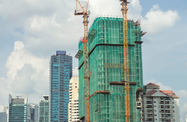High levels of state and private sector investment will drive double-digit growth in Malaysia’s construction industry this year with momentum likely to be maintained into 2015 as more infrastructure projects roll off the drawing board.
The Master Builders Association Malaysia (MBAM) and the Construction Industry Development Board (CIDB) Malaysia forecast growth of at least 10%, the third consecutive year of double-digit expansion. Growth will be sustained in part by transport and infrastructure mega-projects such as Tun Razak Exchange – a financial center – line two of the Klang Valley Mass Rapid Transit (MRT) and West Coast Expressway, according to MBAM president Matthew Tee. “These projects are yet to start ... so I don’t think the number of construction projects will drop in the next few years. There should be a consistent growth in the industry moving forward,” Tee told local media.
The chairman of CIDB Malaysia, Tan Sri Dr Ahmad Tajuddin Ali, reiterated that the industry would benefit from increased investments in infrastructure development. “Currently, we have mega projects, particularly the light rail transit (LRT) and MRT, which involve local and foreign companies and they provide jobs to the people, directly or indirectly,” he told a media briefing in September.
Spurred on by massive capital expenditure projects, growth in the construction sector has been outpacing GDP expansion in recent years. The government’s Economic Transformation Programme (ETP) and public-private partnership (PPP) projects have spearheaded much of this growth. This led to a multiplier effect across the industry, which expanded by 11.4%, 4.7%, 18.1% and 10.1% from 2010 to 2013, respectively, according to data from Bank Negara Malaysia (BNM), the central bank.
Leading growth
In an August report, local financial services firm RAM Ratings said the construction sector would likely be the best performer in terms of expansion for the rest of the year after revising its economic forecasts and GDP growth projection to 5.6% for 2014, compared to the initially estimated 5.1%. “Construction, manufacturing and services are expected to perform better than initially expected, underscored by the continued strengthening of domestic and external demand drivers,” the report said. “In particular, construction activities are expected to lead this growth, which is projected to come in at 11.6% this year.”
Another factor that could boost construction activity in the last quarter of this year and the first of 2015 is the impending introduction of the goods and services tax (GST), set to come into force next April. Some sectors of the economy could see an uptick in activity due to “front loading”, pushing up the schedule of projects in order to beat any cost increases resulting from the GST. Fears of a rise in materials and labour costs, driving up the budgets of projects, may prompt firms to bring forward investments on plants and equipment.
In late August, Maybank Investment Bank recommended that investors move into a number of leading construction stocks, forecasting good returns on the back of projects linked to transport infrastructure. Malaysian infrastructure group Gamuda is noted, thanks to its successful bid for the Penang integrated transportation project worth RM5.5bn ($1.7bn). “The Klang Valley MRT’s construction also provides earnings visibility to the group,” said Maybank’s Lee Cheng Hooi, quoted by local media.
It is not just building firms themselves that will gain value over the coming six months; materials suppliers and construction equipment and machinery companies are also likely to benefit from the ongoing boom, with the continued flow of investments being channelled all along the industrial chain.
Cooling phase
According to data issued by BNM in mid-August, the economy grew 6.4% in the second quarter year on year (y-o-y) while the construction industry climbed 9.9%. Despite the growth, the rate of expansion was down compared to the first three months of 2014, when it recorded an 18.9% surge y-o-y thanks to a sharp rise in new real estate developments.
According to the Malaysian Institute of Economic Research (Mier), the residential segment appears to have entered “a cooling phase” in the first two quarters, with sales expected to stay “moderate” for the coming third quarter. Its Residential Property Index fell for the second quarter to 109.9 points, slipping 1.3 points from the first quarter, and 28.3 points from a year ago.
The survey also showed that total unsold new residential properties have accumulated faster than sales in recent months. However, BNM officials told local media that further measures to cool activity in the property sector were not necessary given some moderation in household debt.
Follow Oxford Business Group on Facebook, Google+ and Twitter for all the latest Economic News Updates. Or register to receive updates via email.

